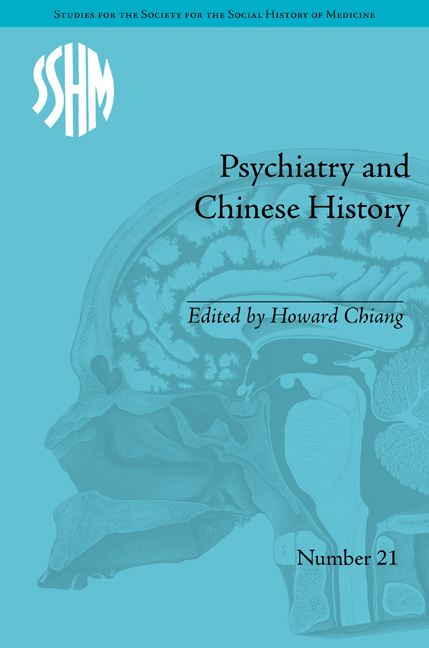Book contents
- Frontmatter
- CONTENTS
- Dedication
- List of Contributors
- List of Figures
- Introduction: Historicizing Chinese Psychiatry
- Part I Historical Precedents
- Part II Missionary Investments
- Part III Biomedical Modernity
- 7 Pathologizing Marriage: Neuropsychiatry and the Escape of Women in Early Twentieth-Century China
- 8 Gone with the West Wind: The Emergence and Disappearance of Psychotherapeutic Culture in China, 1936–68
- 9 A Charted Epidemic of Trauma: Case Notes at the Psychiatric Department of National Taiwan University Hospital between 1946 and 1953
- Part IV New Therapeutic Cultures
- Afterword: Reframing Psychiatry in China
- Notes
- Index
9 - A Charted Epidemic of Trauma: Case Notes at the Psychiatric Department of National Taiwan University Hospital between 1946 and 1953
from Part III - Biomedical Modernity
- Frontmatter
- CONTENTS
- Dedication
- List of Contributors
- List of Figures
- Introduction: Historicizing Chinese Psychiatry
- Part I Historical Precedents
- Part II Missionary Investments
- Part III Biomedical Modernity
- 7 Pathologizing Marriage: Neuropsychiatry and the Escape of Women in Early Twentieth-Century China
- 8 Gone with the West Wind: The Emergence and Disappearance of Psychotherapeutic Culture in China, 1936–68
- 9 A Charted Epidemic of Trauma: Case Notes at the Psychiatric Department of National Taiwan University Hospital between 1946 and 1953
- Part IV New Therapeutic Cultures
- Afterword: Reframing Psychiatry in China
- Notes
- Index
Summary
Introduction
In the early years after the Second World War, the island of Taiwan saw a rapid growth of psychoneurotic patients across different ethnic groups. This hidden ‘epidemic’ remained covered until the case notes of the Department of Psychiatry at the National Taiwan University Hospital were unearthed recently. The causation of these disorders among the suffering individuals is assumed to be dissimilar. The emergence of this phenomenon could be grounded on the external reality of the post-war societal turmoil, the altered aspiration of psychiatric services, and most importantly, the psychiatrists who found themselves accountable for the betterment among those who sought their help. This chapter, as the first attempt to study the case notes kept by the Department of Psychiatry at the National Taiwan University Hospital (NTUH), aims to unpack the contextual meaning of such a mental disorder epidemic through analyzing this clinical archive.
Psychiatry in early post-war Taiwan experienced the re-institutionalization of the discipline during the handover period between two political regimes, in large part due to the social upheaval that caused mental instability in this context. Under these circumstances, psychiatrists managed to diagnose individuals who sought help from the newly established National Taiwan University Hospital. Facilitating the process were a newly acquired linguistic resource of psychiatry, and a newly learned medical technology to treat the unsound minds. Apart from psychotic patients who already existed at a relatively unchanging rate, the sudden increasing epidemic of psychoneuroses marked the professional interests of psychiatry.
- Type
- Chapter
- Information
- Psychiatry and Chinese History , pp. 161 - 182Publisher: Pickering & ChattoFirst published in: 2014



